
The Solar-Terrestrial Centre of Excellence (STCE) is a collaborative network of the Belgian Institute for Space Aeronomy, the Royal Observatory of Belgium and the Royal Meteorological Institute of Belgium.
 |
Published by the STCE - this issue : 2 Jan 2015. The Solar-Terrestrial Centre of Excellence (STCE) is a collaborative network of the Belgian Institute for Space Aeronomy, the Royal Observatory of Belgium and the Royal Meteorological Institute of Belgium. |
| Archive of the newsletters | Subscribe to this newsletter by mail |
In its New Year's letter for 2014, the Sun promised great solar activity to come (http://www.stce.be/news/231/welcome.html). True to its word, sunspot numbers reached a new monthly high in February 2014, probably indicating the maximum of the ongoing solar cycle. Throughout the year, this increased sunspot activity was accompanied by plenty of strong flares, big sunspot groups and geomagnetic unrest.
A compilation of the most memorable moments of 2014 can be found underneath. Using Helioviewer (http://helioviewer.org/), a MOVIE (https://www.youtube.com/watch?v=dnTMtpNvlyc) was created containing one or more clips of each event. Usually, SDO-images (http://sdo.gsfc.nasa.gov/data/aiahmi/) were used, occasionally supplemented with imagery from STEREO (http://stereo.gsfc.nasa.gov/), PROBA2 (http://proba2.oma.be/ssa), and SOHO (http://sohowww.nascom.nasa.gov/).
Happy reading, and the best wishes for a wonderful New Year!
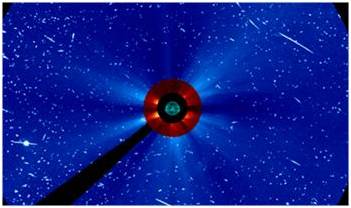
Ref: STCE news item of 16 January 2014 at http://www.stce.be/news/232/welcome.html
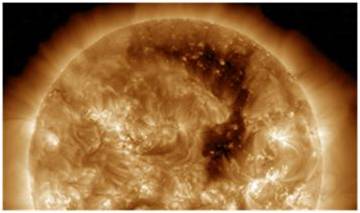
Ref: STCE Newsletter of 16 January 2014 at http://www.stce.be/newsletter/pdf/2014/STCEnews20140116.pdf
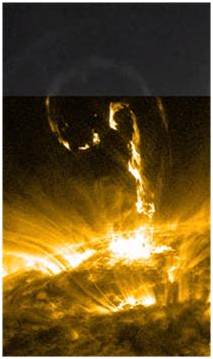
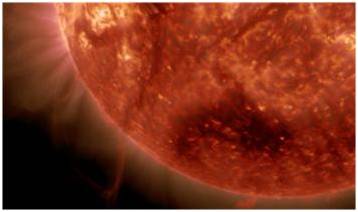
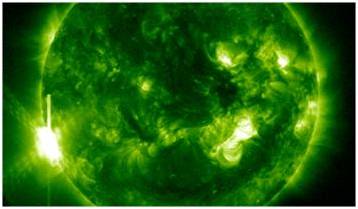
Ref: STCE news item of 18 June 2014 at http://www.stce.be/news/256/welcome.html
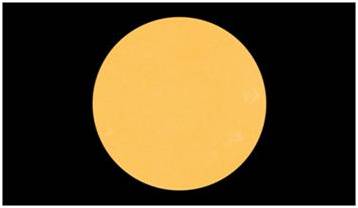
Ref: STCE news item of 31 July 2014 at http://www.stce.be/news/261/welcome.html
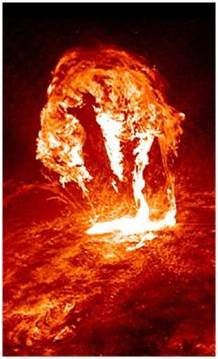
Ref: STCE news item of 27 August 2014 at http://www.stce.be/news/264/welcome.html
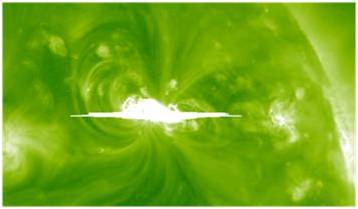
Ref: STCE news item of 9 September 2014 at http://www.stce.be/news/266/welcome.html
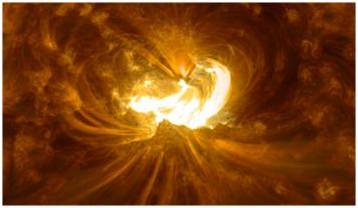
Ref: STCE news items of 10-11 September 2014 at http://stce.be/news/267/welcome2.html , and of 17 September 2014 at http://www.stce.be/news/268/welcome.html
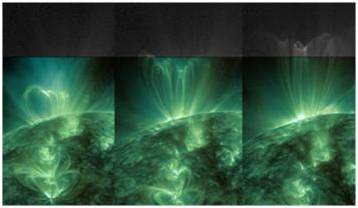
Ref: STCE news item of 21 October 2014 at http://www.stce.be/news/274/welcome.html
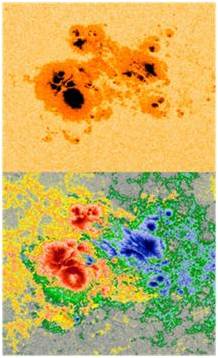
Ref: STCE news items of 29 October at http://www.stce.be/news/280/welcome.html and of 26 November 2014 at http://www.stce.be/news/285/welcome.html
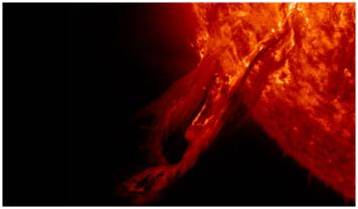
Ref: STCE news item of 5 November 2014 at http://www.stce.be/news/281/welcome.html
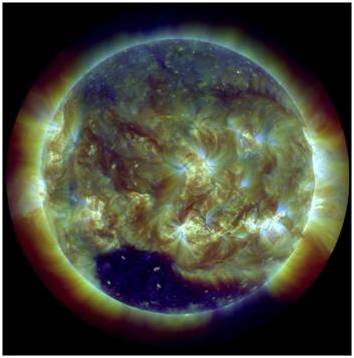
Ref: STCE Newsletter of 12 December 2014 at http://www.stce.be/newsletter/pdf/2014/STCEnews20141212.pdf
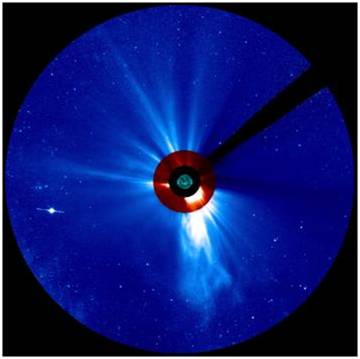
Ref: This just hot off the press!
During the week of 15 December, 1 X-, 8 M- and 48 C-class flares were observed. All strong flares, as well as the very large majority of the C-class flares were produced by beta-gamma-delta regions NOAA 2241 and NOAA 2242. At least one strong flare was observed every day from 17-22 December. During the week of 22 December, there were 2 M- and 37 C-class flares, with NOAA 2241/2242 the most flare productive from 22-24 December while rounding the west solar limb. From then on, beta-gamma regions NOAA 2248 and NOAA 2249 took over with a low-level M2 flare from NOAA 2249 on 27 December. The X-ray background flux was above the C1-level from 17-22 and on 24-25 December.
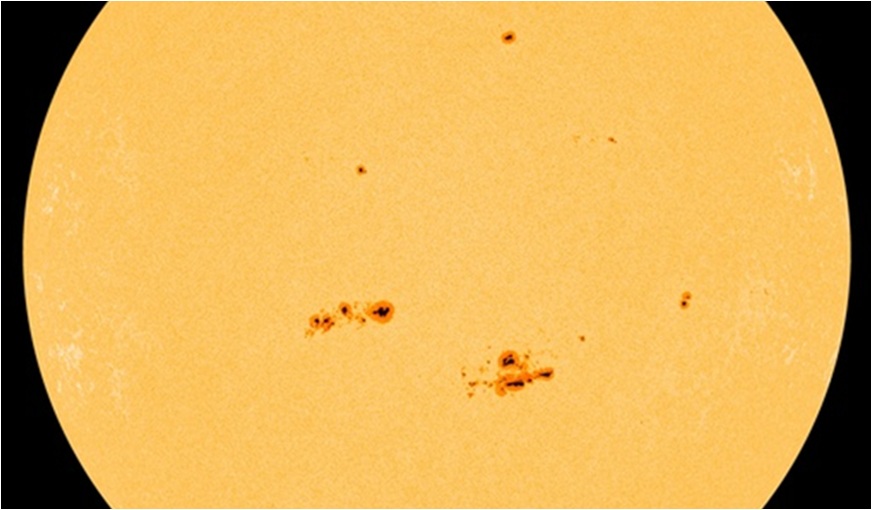
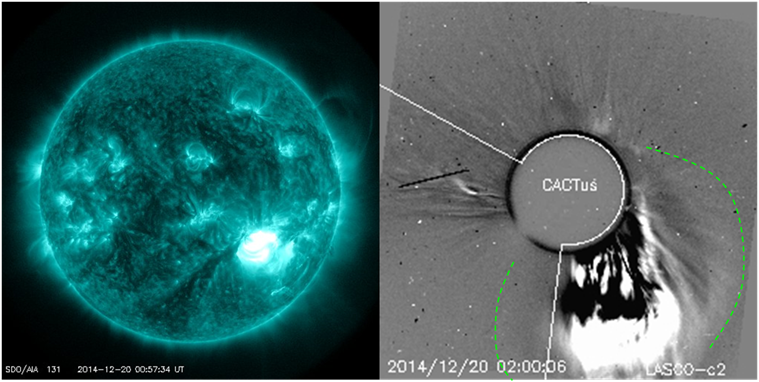
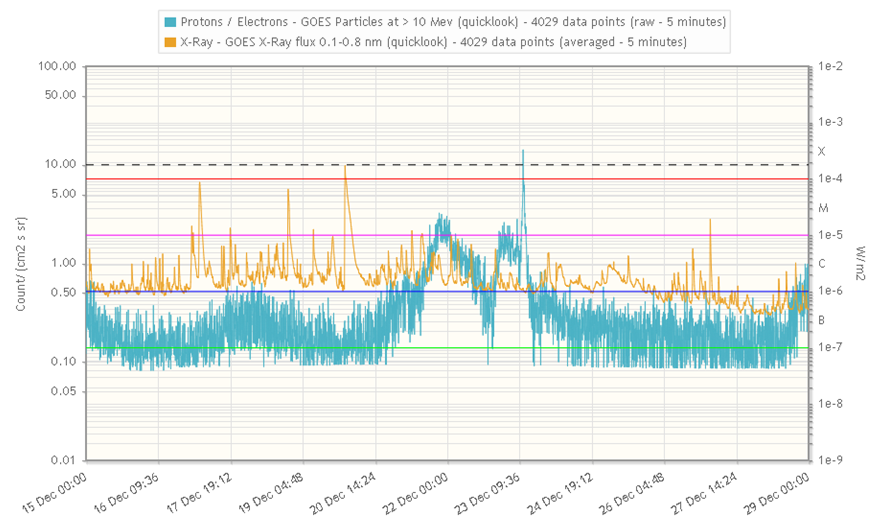
| DAY | BEGIN | MAX | END | LOC | XRAY | OP | 10CM | TYPE | Cat | NOAA |
| 17 | 0057 | 0110 | 0120 | S25E10 | M1.5 | 1N | 2242 | |||
| 17 | 0141 | 0150 | 0157 | S11E33 | M1.1 | SN | VI/1 | 2241 | ||
| 17 | 0425 | 0451 | 0520 | S20E9 | M8.7 | 2B | 320 | II/3IV/1III/2 | 2242 | |
| 17 | 1854 | 1901 | 1920 | M1.4 | I/2I/1/1 | 2241 | ||||
| 18 | 2141 | 2158 | 2225 | M6.9 | N | 240 | I/2V/1TM/1I/2 6 | 39 | 2241 | |
| 19 | 0931 | 0944 | 0954 | M1.3 | N | 38 | 2242 | |||
| 20 | 0011 | 0028 | 0055 | S21W24 | X1.8 | 3B | 2300 | VI/2II/1 | 38 | 2242 |
| 21 | 0718 | 0732 | 0751 | S21W48 | M1.2 | 1N | 38 | 2242 | ||
| 21 | 1124 | 1217 | 1257 | M1.0 | VI/2 | 39 | 2241 |
| LOC: approximate heliographic location | TYPE: radio burst type |
| XRAY: X-ray flare class | Cat: Catania sunspot group number |
| OP: optical flare class | NOAA: NOAA active region number |
| 10CM: peak 10 cm radio flux |
| DAY | BEGIN | MAX | END | LOC | XRAY | OP | 10CM | TYPE | Cat | NOAA |
| 22 | 0133 | 0149 | 0159 | S19W54 | M1.0 | 1F | 38 | 2242 | ||
| 27 | 0203 | 0216 | 0224 | S11W48 | M2.2 | 2B | 2249 |
| LOC: approximate heliographic location | TYPE: radio burst type |
| XRAY: X-ray flare class | Cat: Catania sunspot group number |
| OP: optical flare class | NOAA: NOAA active region number |
| 10CM: peak 10 cm radio flux |
Solar flare activity fluctuated between low and high during the week.
In order to view the activity of this week in more detail, we suggest to go to the following website from which all the daily (normal and difference) movies can be accessed: http://proba2.oma.be/ssa
This page also lists the recorded flaring events.
A weekly overview movie can be found here (SWAP week 247).
http://proba2.oma.be/swap/data/mpg/movies/weekly_movies/weekly_movie_2014_12_15.mp4
Details about some of this week's events, can be found further below.
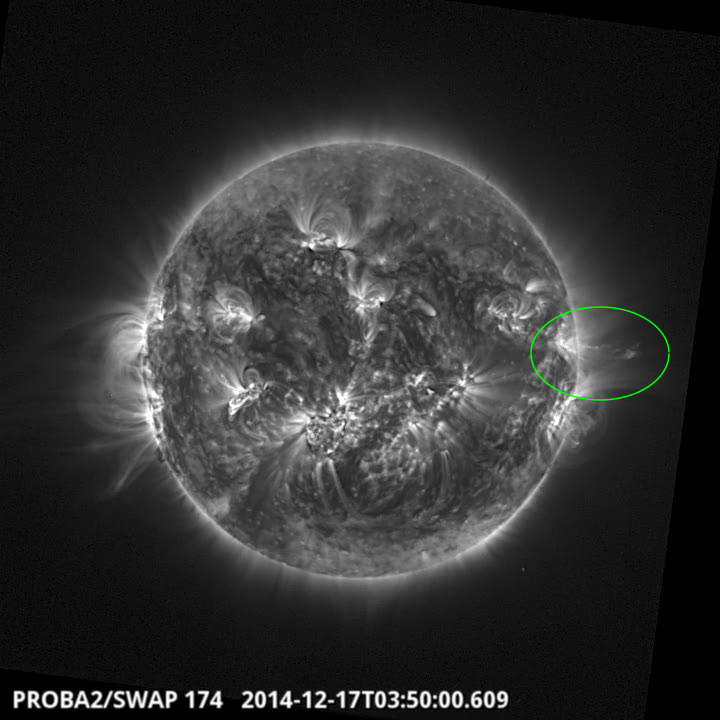
Eruption on the west limb @ 03:50 SWAP image
Find a movie of the event here (SWAP movie)
http://proba2.oma.be/swap/data/mpg/movies/20141217_swap_movie.mp4
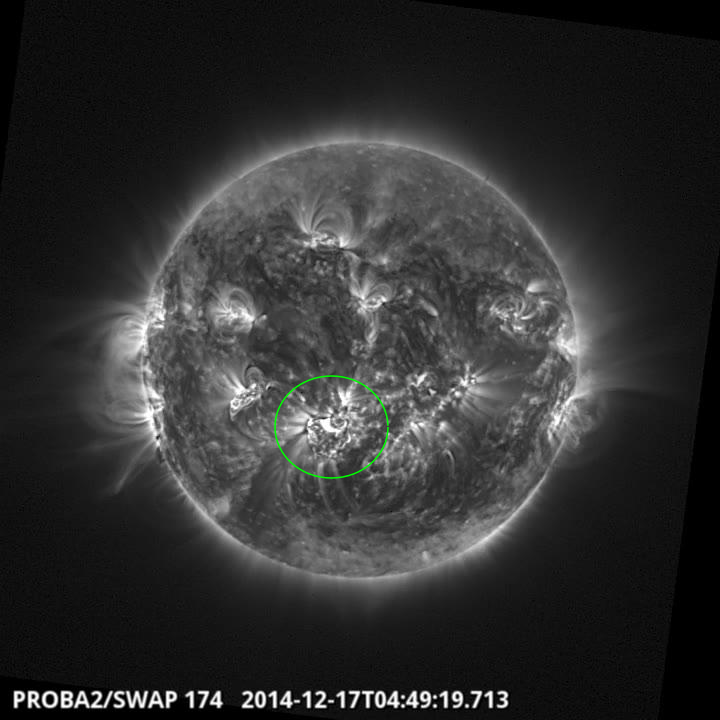
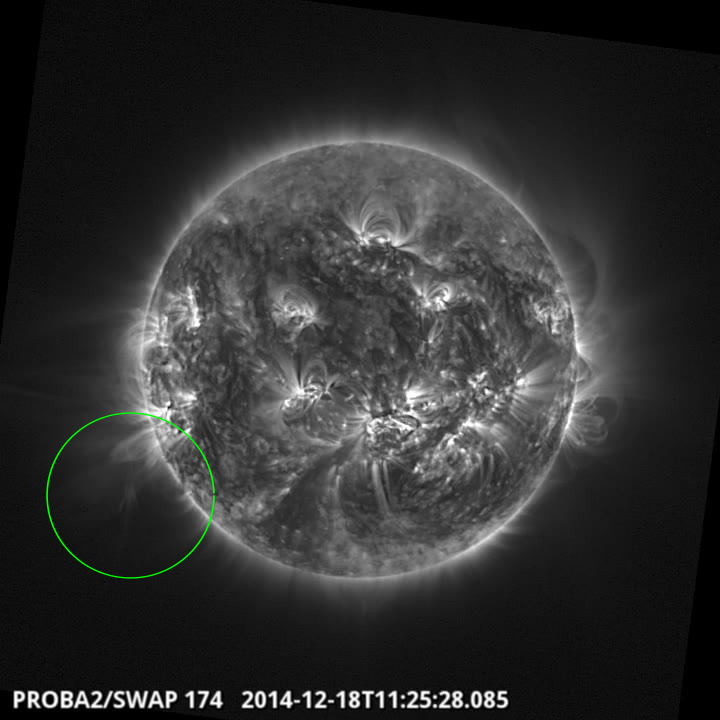
Eruption on the east limb @ 11:25 SWAP image
Find a movie of the event here (SWAP movie)
http://proba2.oma.be/swap/data/mpg/movies/20141218_swap_movie.mp4
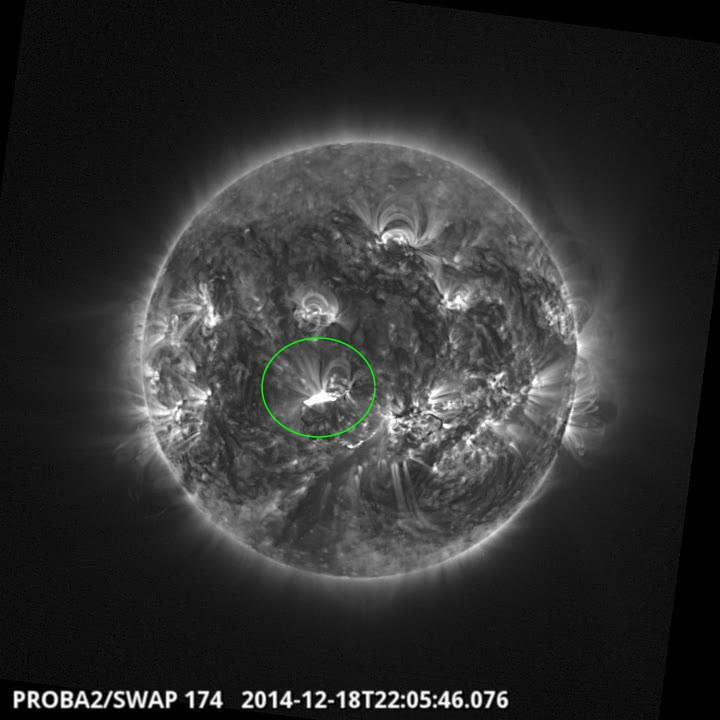
Mflare in the Sun’s centre @ 22:05 SWAP image
Find a movie of the event here (SWAP movie)
http://proba2.oma.be/swap/data/mpg/movies/20141218_swap_movie.mp4
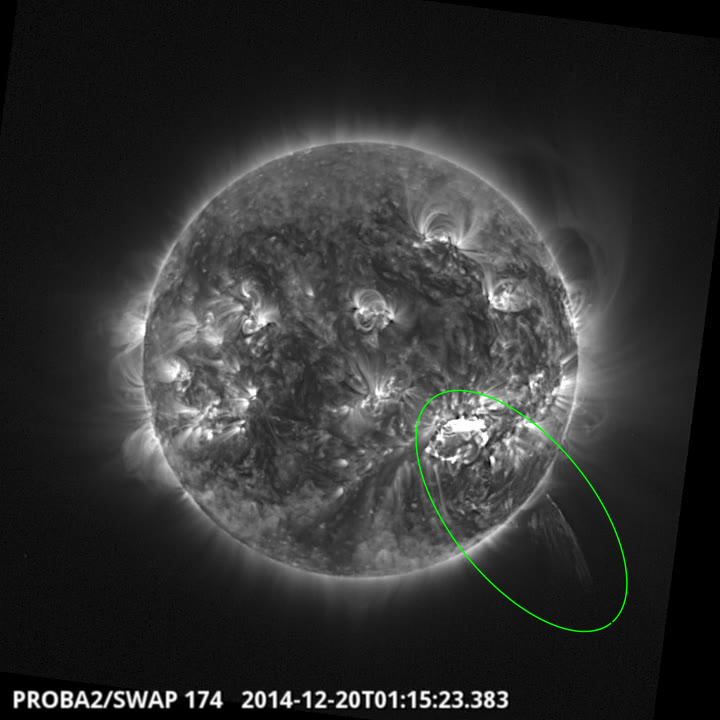
Xflare on the south west quad @ 01:15 SWAP image
Find a movie of the event here (SWAP movie)
http://proba2.oma.be/swap/data/mpg/movies/20141220_swap_movie.mp4
Solar wind speed as observed by ACE started the period with nominal values between 330 and 540 km/s. The magnitude of the Interplanetary Magnetic Field (IMF) was stable and varied between 5 and 10 nT. Around 02:30UT on 21 December, the IMF jumped from 6 to 8 nT without a significant jump in solar wind speed. This discontinuity was probably the signature of the arrival of the CME from 17 December. See annotated ACE chart underneath (triangles mark the arrival of the discontinuity and shocks).
ACE observed a shock in the solar wind at 18:25UT on 21 December. Solar wind velocity went from 360 to 440 km/s instantaneously, accompanied by a sudden increase of the solar wind density and temperature. The magnitude of the IMF suddenly increased from 9 to 17 nT. This was probably a signature of the arrival of the CME from 19 December. Initially, active geomagnetic (Kp=4) conditions were recorded between 18:00-24:00UT on December 21. However, combined with a Bz that was mostly below -15 nT between 00:00-04:00UT on 22 December, the shock caused minor geomagnetic storm (Kp=5) registered between 00:00-06:00UT on 22 December. At Dourbes, K values of 3 to 4 were registered during the same period.
Solar wind measurements revealed the arrival of a second shock at 14:25UT on 22 December, related to the 20 December CME. Solar wind speed increased from 380 to about 460 km/s. Simultaneously, the magnitude of the IMF went from 18 to 26 nT and decreased then later on.
A third shock was recorded at 10:30UT on 23 December, and was associated to the 21 December CME. A sudden increase in solar wind speed occurred, going from 350 to 550 km/s, accompanied by a jump in density and temperature. The IMF magnitude jumped from 10 to 33 nT. Bz was mainly positive on 22 and 23 December, but turned negative near the end of the 23rd. This resulted in active geomagnetic conditions and locally a brief episode of minor storming was recorded.
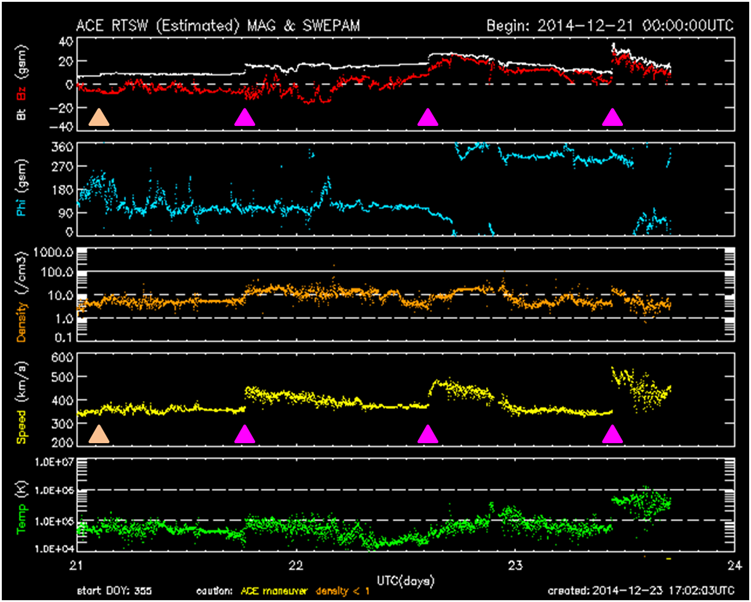
For the remainder of the week (from 24 till late 28 December), the solar wind speed varied mostly between 540 and 350 km/s, in an overall decreasing trend. The IMF magnitude varied between 5 and 13 nT, with a fluctuating, but quite often negative, Bz component. Local geomagnetic activity (Dourbes) showed numerous episodes of active levels (K=4) from 22 till 26 December, with one time slot of minor storm level late on 23 December, in response of CME activity as discussed above. Quiet conditions resumed from then on.
Around 18:00UT on 28 December, the solar wind speed started to increase and was still increasing by the end of the period. This high speed stream (HSS) is likely related to a coronal hole (CH) that crossed the central meridian on 22-23 December. Active geomagnetic conditions to locally minor geomagnetic storming were observed.
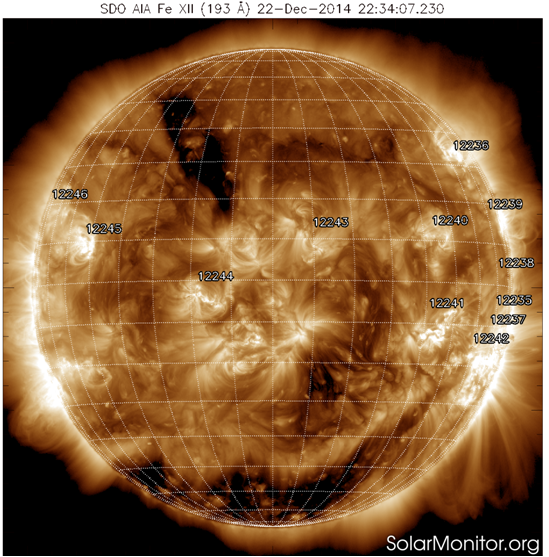
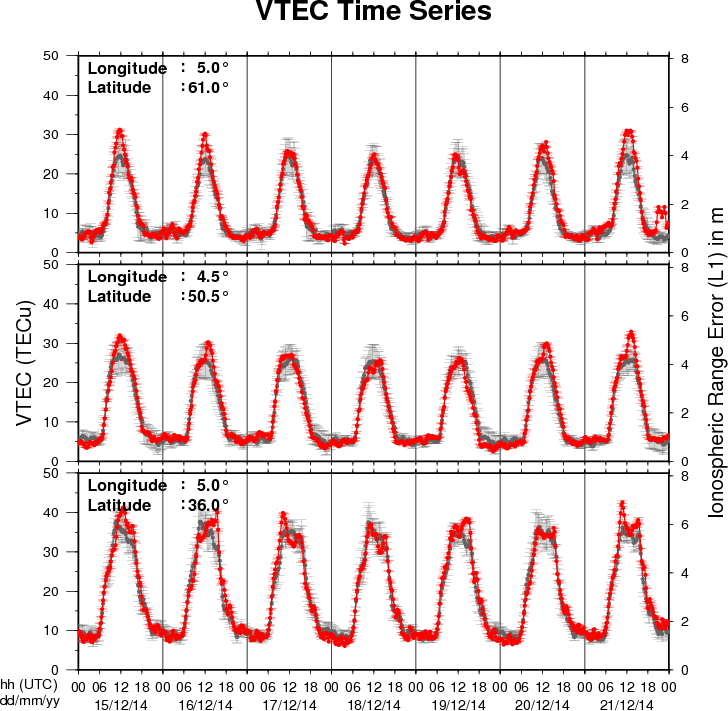
The figure shows the time evolution of the Vertical Total Electron Content (VTEC) (in red) during the last week at three locations:
a) in the northern part of Europe(N61°, 5°E)
b) above Brussels(N50.5°, 4.5°E)
c) in the southern part of Europe(N36°, 5°E)
This figure also shows (in grey) the normal ionospheric behaviour expected based on the median VTEC from the 15 previous days.
The VTEC is expressed in TECu (with TECu=10^16 electrons per square meter) and is directly related to the signal propagation delay due to the ionosphere (in figure: delay on GPS L1 frequency).
The Sun's radiation ionizes the Earth's upper atmosphere, the ionosphere, located from about 60km to 1000km above the Earth's surface.The ionization process in the ionosphere produces ions and free electrons. These electrons perturb the propagation of the GNSS (Global Navigation Satellite System) signals by inducing a so-called ionospheric delay.
See http://stce.be/newsletter/GNSS_final.pdf for some more explanations ; for detailed information, see http://gnss.be/ionosphere_tutorial.php
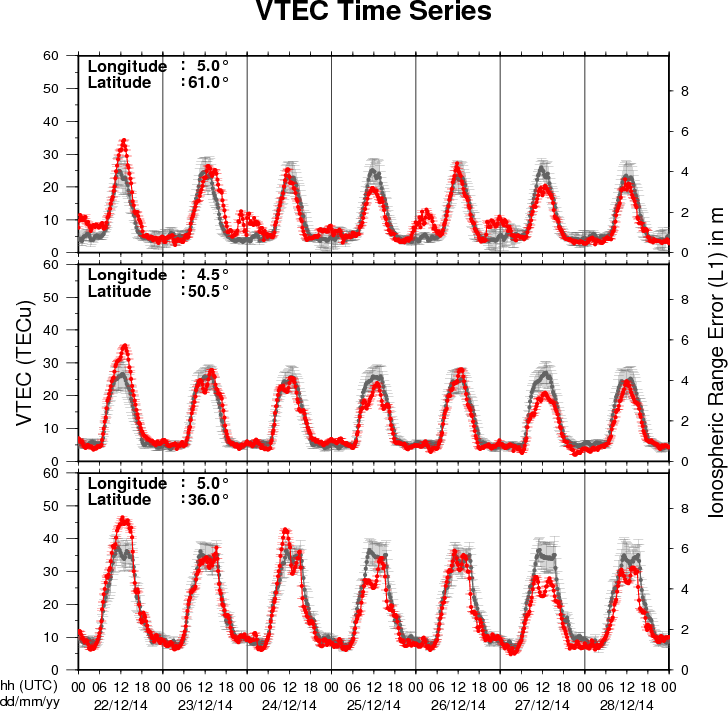
The figure shows the time evolution of the Vertical Total Electron Content (VTEC) (in red) during the last week at three locations:
a) in the northern part of Europe(N61°, 5°E)
b) above Brussels(N50.5°, 4.5°E)
c) in the southern part of Europe(N36°, 5°E)
This figure also shows (in grey) the normal ionospheric behaviour expected based on the median VTEC from the 15 previous days.
The VTEC is expressed in TECu (with TECu=10^16 electrons per square meter) and is directly related to the signal propagation delay due to the ionosphere (in figure: delay on GPS L1 frequency).
The Sun's radiation ionizes the Earth's upper atmosphere, the ionosphere, located from about 60km to 1000km above the Earth's surface.The ionization process in the ionosphere produces ions and free electrons. These electrons perturb the propagation of the GNSS (Global Navigation Satellite System) signals by inducing a so-called ionospheric delay.
See http://stce.be/newsletter/GNSS_final.pdf for some more explanations ; for detailed information, see http://gnss.be/ionosphere_tutorial.php
Start : 2015-03-16 - End : 2015-03-19
This international conference will provide an overview of our
current understanding of Sun-Climate Connections starting at
processes on the Sun itself over space weather and solar wind
towards solar influence on the upper atmosphere down to the ocean.
It will also provide insights into the heatedly debated role of the
Sun in climate change. In four sessions the various contributions
of solar variability influence on Earth's climate will be presented
and discussed by bringing together solar physicists, space
scientists, atmospheric scientists, climate modellers, and
paleoclimatologists.
We expect contributions from scientists participating in
SCOSTEP/ROSMIC, SPARC-SOLARIS/HEPPA, the EU cost network TOSCA, as
well as any other interested scientists. The conference will last
three full days, beginning Monday morning, 16 March 2013. The
programme will consist of invited and keynote lectures, a few
contributed oral presentations and ample time dedicated to poster
sessions. The fourth day will be devoted to public outreach
activities as well as panel discussions.
Website: http://scc.geomar.de/
Start : 2015-05-18 - End : 2015-05-22
URSI AT-RASC 2015 will be the first edition of the newly
established triennial URSI Atlantic Radio Science Conference as one
of the URSI Flagship Conferences. AT-RASC 2015 will have an open
scientific program composed of submitted papers within the domains
covered by all ten Commissions of URSI.
Website: http://www.at-rasc.com/
Start : 2015-06-01 - End : 2015-07-24
The Space Weather Summer School at Los Alamos National
Laboratory, established in 2011 under the founding Director Josef
Koller, is dedicated to space weather, space science and
applications. Every year we solicit applications for the Los Alamos
Space Weather Summer School. This summer school is sponsored and
supported by a number or organizations at LANL. This year our top
sponsors include the Los Alamos Institute of Geophysics, Planetary
Physics and Signatures (IGPPS) and the Laboratory Directed Research
and Development Office (LDRD). The summer school brings together
top space science students with internationally recognized
researchers at LANL in an educational and collaborative
atmosphere.
Website:
http://www.swx-school.lanl.gov/
Start : 2015-07-21 - End : 2015-07-23
The conference will review past and recent achievements, as well
as future challenges in the field of solar coronal loop
physics.
Website:
http://www.damtp.cam.ac.uk/user/astro/cl7/index.html
Start : 2015-07-28 - End : 2015-08-04
Heliophysics is all of the science common to the field of the
Sun-Earth connections. This fast-developing field of research
covers many traditional sub-disciplines of space physics,
astrophysics, and climate studies. The NASA Living with a Star
program, with its focus on the basic science underlying all aspects
of space weather, acts as a catalyst to bring the many research
disciplines together to deepen our understanding of the system of
systems formed by the Sun-Earth connection.
Website:
http://www.heliophysics.ucar.edu/
Start : 2015-07-30 - End : 2015-08-06
The 34th International Cosmic Ray Conference (ICRC) will be held
from July 30 to August 6, 2015, in The Hague, The Netherlands. It
is an important and large conference in the field of Astroparticle
Physics. The ICRC covers: cosmic-ray physics, solar and
heliospheric physics, gamma-ray astronomy, neutrino astronomy, and
dark matter physics.
Website: http://icrc2015.nl
Start : 2015-10-05 - End : 2015-10-09
This CSPM-2015 scientific meeting will cover various aspects of
solar dynamic and magnetic phenomena which are observed over the
entire electromagnetic spectrum: white-light, Hα, Ca II,
and radio from ground and in a variety of other wavelengths (white
light, UV and EUV, and X-rays) from space. Emphasis will also be
placed on instrumentation, observing techniques, and solar image
processing techniques, as well as theory and modelling through
detailed radiative transfer in increasingly realistic MHD models.
The long-term (cyclic) evolution of solar magnetism and its
consequence for the solar atmosphere, eruptive phenomena, solar
irradiation variations, and space weather, will be in focus. Here,
special attention will be devoted to the long-term observations
made in Coimbra and also to the results of the SPRING / SOLARNET
and SCOSTEP VarSITI studies. In particular, the weak solar activity
during the current solar maximum will be discussed. Finally, since
this meeting is organised around the 90th anniversary of performing
the first spectroheliographic observations in Coimbra, a session
will be specially dedicated to new solar instruments (both
ground-based and space-borne) that will give access to unexplored
solar atmospheric features and dynamic phenomena over the coming
years.
Website:
http://www.mat.uc.pt/~cspm2015/
Start : 2016-07-30 - End : 2016-08-07
The 41st COSPAR Scientific Assembly will be held in Istanbul,
Turkey from 30 July - 7 August 2016. This Assembly is open to all
bona fide scientists.
Website:
https://www.cospar-assembly.org/
Lecture focusing on the effects of space weather, extreme space weather during SC24, and the space weather forecasting at the Space Pole (RWC Brussels). The lecture was given to the Public Observatory Beisbroek / COZMIX in Beisbroek, Brugge, Belgium. Solar amateur astronomers and public audience, in Dutch, about 35 attendees.
http://www.spaceweather.eu/en/repository/show?id=554
This presentation was given during the "ESWW11 – Forecaster Forum" splinter on 18 November 2014. It focuses on the forecast and evaluation of the flaring activity in sunspot group NOAA 2158 (September 2014). There were about 70 attendees (scientists).
http://www.spaceweather.eu/en/repository/show?id=555